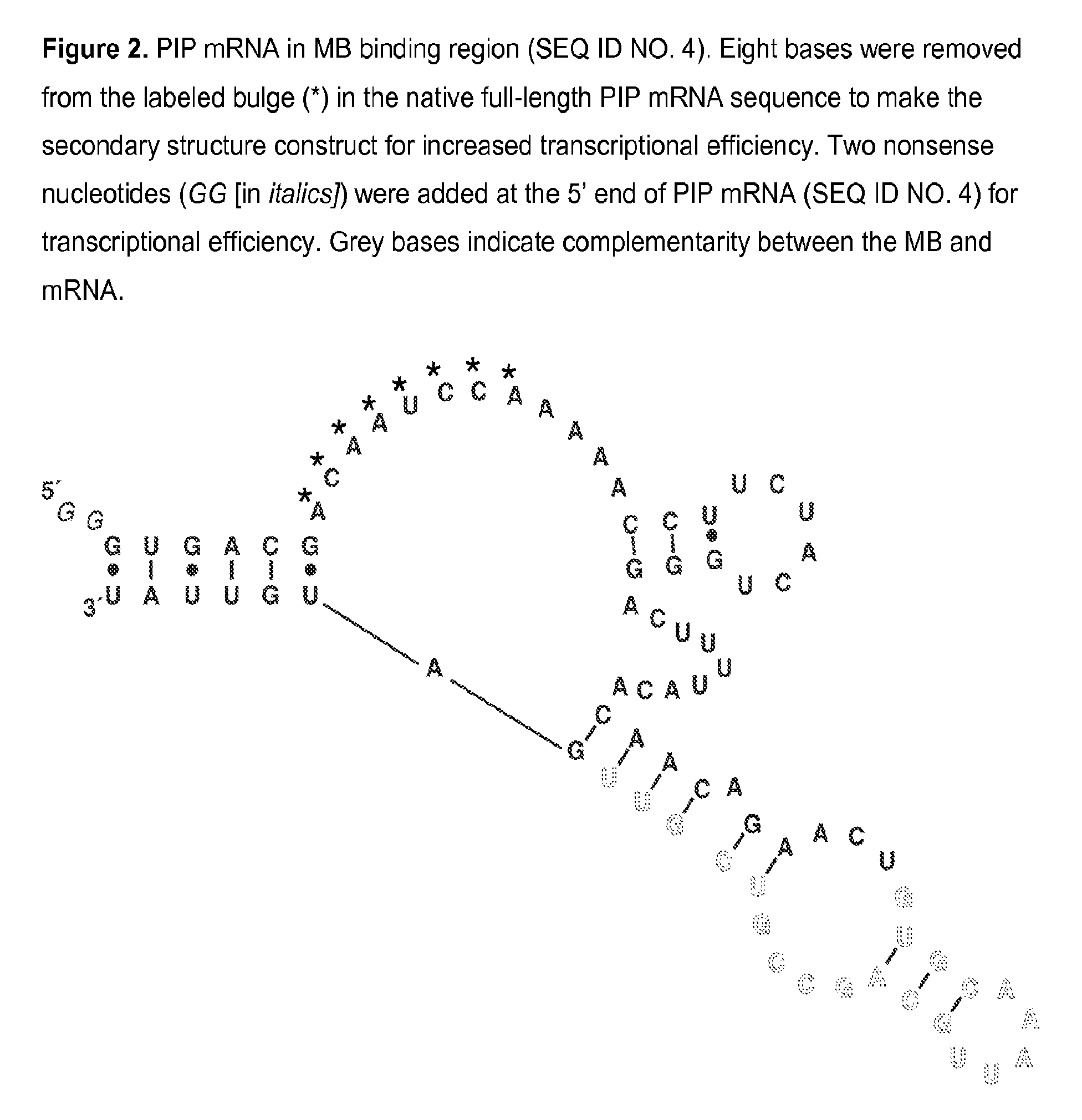Molecular beacon based assay for the detection of biomarkers for breast cancer metastasis
a breast cancer and biomarker technology, applied in biochemistry apparatus and processes, organic chemistry, sugar derivatives, etc., can solve the problems of inability to detect low number of tumor cells, and relatively painless serum sampling technique, so as to achieve the effect of robustness of assay, and reduce the total analysis tim
- Summary
- Abstract
- Description
- Claims
- Application Information
AI Technical Summary
Benefits of technology
Problems solved by technology
Method used
Image
Examples
example 1
Preparation of Human PIP cDNA and Human PIP mRNA
[0068]All nucleic acids were purified by polyacrylamide gel electrophoresis (PAGE) before use. Nucleic acids were denatured at 70° C. for 2 minutes, mixed 2:1 with loading dye (8 M urea; 20 mM EDTA; 5 mM Tris-HCl, pH 7.5; 0.5% w / v xylene cyanol; and 0.5% w / v bromophenol blue), and separated on 20 percent polyacrylamide gels (24 g urea; 25 mL 40% polyacrylamide; 10 mL 5×TBE) at 17 W per gel for approximately 3 hours. DNA was visualized with UV shadowing (100-280 nm). RNA was visualized by ethidium bromide staining of a thin, vertical strip of gel. DNA and unstained RNA were extracted by cutting bands from the gels, crushing, and tumbling over night in water. This process was performed twice and the eluate from both extractions was combined. Extracts were purified by chloroform extraction (24:1 chloroform:isoamyl alcohol solution saturated with TE buffer) and ethanol precipitation. Purified products were reconstituted in 50 μL of sterile...
example 2
Preparation of a PIP Molecular Beacon
[0074]A PIP MB was designed based on the mRNA sequence for PIP mRNA (NCBI Accession NM_002652) which was determined using GenBank entries and a literature reference. Expected mRNA secondary structures were modeled using mfold energy minimization and a region of secondary structure that was conserved in the majority of possible structures was found. The MB sequence is complementary to the region of conserved secondary structure and incorporates nucleotides at the 5′ and 3′ ends which are self-complementary, thereby forming a closed, stem-loop structure. A PIP MB DNA, 5′-TGTGCAACGACGGCTGCAATTTGCACA-3′ (SEQ ID NO. 6), was chemically synthesized and modified to incorporate a fluorophore and a quencher at the 5′ and 3′ ends, respectively. A PIP MB of the invention consists essentially of tetrachloro-6-carboxyfluorescein-TGTGCAACGACGGCTGCAATTTGCACA (SEQ ID NO. 6)-BLACK HOLE QUENCHER® 1.
example 3
Analysis of the Binding of the PIP Molecular Beacon to PIP mRNA
[0075]Samples were prepared to give final concentrations of 50 mM HEPES, pH 7.5; 100 mM MgCl2; 200 mM KCl; 25 mM DTT; 20 nM MB. All solutions were heated to 95° C. for 2 minutes and allowed to anneal at room temperature prior to analysis. Fluorescence emission was monitored with excitation at 521+ / −5 nm and emission at 535+ / −5 nm at 25° C. using a Cary Eclipse fluorescence spectrophotometer (Agilent Technologies, Inc., Santa Clara, Calif.).
[0076]For temporal analysis of MB-mRNA hybridization, each MB sample was spiked with mRNA after establishing a fluorescence baseline. Fluorescence emission was then monitored for 30-60 minutes before the samples were heated to 95° C. for 2 minutes and annealed at room temperature. Emission was monitored for 10 minutes after annealing.
[0077]To evaluate the in vitro MB binding to mRNA, the baseline fluorescence intensity was established, target mRNA was then added, the nucleic acids were...
PUM
| Property | Measurement | Unit |
|---|---|---|
| quenching wavelength range | aaaaa | aaaaa |
| quenching wavelength | aaaaa | aaaaa |
| quenching wavelength range | aaaaa | aaaaa |
Abstract
Description
Claims
Application Information
 Login to View More
Login to View More - R&D
- Intellectual Property
- Life Sciences
- Materials
- Tech Scout
- Unparalleled Data Quality
- Higher Quality Content
- 60% Fewer Hallucinations
Browse by: Latest US Patents, China's latest patents, Technical Efficacy Thesaurus, Application Domain, Technology Topic, Popular Technical Reports.
© 2025 PatSnap. All rights reserved.Legal|Privacy policy|Modern Slavery Act Transparency Statement|Sitemap|About US| Contact US: help@patsnap.com



